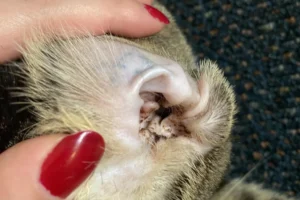Cat ears are one of the most sensitive parts of a feline’s body, but have you ever wondered why that is? Let’s explore the reasons behind why cat ears are so sensitive.
Anatomy of Cat Ears
Cat ears are not just adorable accessories on top of their heads; they play a crucial role in a feline’s sensory experience. The physical structure of cat ears is a fascinating mix of muscles, blood vessels, and nerve endings that contribute to their sensitivity.
The outer part of a cat’s ear is covered in a layer of specialized skin that is thin and delicate, allowing for maximum flexibility and movement. This thin skin is packed with blood vessels, which help regulate the temperature of the ears and ensure optimal blood flow to maintain their sensitivity.
Furthermore, the muscles in a cat’s ears are incredibly agile and powerful, allowing them to rotate their ears up to 180 degrees to hone in on sounds from different directions. These muscles work in harmony with the numerous nerve endings present in the ears, which are extremely sensitive to even the slightest vibrations in the air.
In essence, the intricate blend of muscles, blood vessels, and nerve endings in a cat’s ears creates a finely-tuned sensory system that enables them to detect the most subtle sounds and movements in their environment. It’s no wonder cats can hear a mouse scurrying from yards away!
Hearing Abilities
A cat’s ears are not just cute; they are powerhouses of auditory prowess. A feline’s acute sense of hearing is directly linked to the sensitivity of their ears, allowing them to pick up on a wide range of sounds that are imperceptible to the human ear.
One fascinating aspect of a cat’s hearing abilities is their impressive frequency range. While humans can hear sounds up to 20,000 Hz, cats can detect frequencies as high as 65,000 Hz. This heightened sensitivity to high-pitched sounds explains why your cat may twitch its ears at seemingly inaudible noises.
Additionally, a cat’s ears are designed to amplify and localize sounds effectively. The unique shape of their outer ears acts as natural receptors, capturing and funneling sounds towards their ear canals with precision. This exceptional hearing capability not only helps cats hunt effectively but also allows them to communicate with their fellow felines through subtle vocalizations.
In essence, a cat’s sensitive ears are finely-tuned instruments that enable them to navigate the auditory world with unmatched precision and acuity. So, the next time your cat perks up its ears at the slightest sound, remember that it’s all thanks to their remarkable hearing abilities.
Communication through Ears
Did you know that cats use their ears to communicate with humans and other animals? It’s true – those cute little ears play a crucial role in their social interactions. Cats can rotate their ears 180 degrees to listen for sounds in different directions, showing their alertness and curiosity. When a cat’s ears are facing forward, they are typically feeling friendly and approachable, but if they are flattened backward, it could be a sign of fear or aggression. So, next time you see a cat flicking its ears around, pay attention – it might be trying to tell you something!
Grooming and Maintenance
Cats’ sensitive ears require regular grooming and maintenance to keep them clean and healthy. Neglecting this could lead to health issues such as ear infections or mites, causing discomfort for your furry friend. To clean your cat’s ears, gently wipe the outer ear with a damp cotton ball or a soft cloth. Avoid using cotton swabs as they can damage the delicate inner ear. If you notice any signs of ear irritation or odor, consult your veterinarian for proper care. Remember, a little TLC goes a long way in keeping your cat’s ears in tip-top shape!
Bonus Tip: Regularly check your cat’s ears for any signs of redness, swelling, or discharge, as these could indicate an underlying issue that requires prompt attention. Your vigilance can help catch potential problems early and ensure your cat’s ear health is on point.
Sensitivity to Touch
Cat ears are incredibly sensitive to touch due to the numerous nerve endings present in the ear structure. This sensitivity allows cats to pick up even the slightest sounds in their environment, helping them stay alert to potential dangers or prey. When petting your feline friend, it’s crucial to be gentle and avoid applying too much pressure on their ears. A light touch can be soothing for your cat, while rough handling can cause discomfort or even pain. By respecting your cat’s ear sensitivity and handling them with care, you can strengthen the bond you share with your furry companion.
Sensory Overload
A cat’s sensitive ears can sometimes lead to sensory overload, especially in noisy or chaotic environments. Loud noises, sudden sounds, or even high-pitched sounds can overwhelm your cat, causing stress and anxiety. To create a calming environment for your feline friend, try to minimize loud noises, provide a quiet retreat space, and consider playing soft music or using white noise to mask disturbing sounds. By being aware of your cat’s sensitivity to noise and taking steps to reduce sensory overload, you can help your cat feel more relaxed and content in their surroundings.
Additional Unique Insight:
- Consider using earmuffs or earplugs designed for cats to help reduce noise sensitivity in situations where loud sounds are unavoidable. These specialized products can provide a comfortable and effective way to protect your cat’s ears from overwhelming sounds.
Common Ear Issues
Cats have incredibly sensitive ears, making them prone to a variety of common ear issues. One of the most prevalent problems is ear infections. These can be caused by bacteria, yeast, or even mites, leading to symptoms like head shaking, scratching, and ear discharge. Additionally, ear mites are a pesky issue that can cause extreme discomfort for your feline friend. Allergies are another culprit for ear problems in cats, with environmental factors or food allergies potentially triggering inflammation and itchiness in the ears.
Tips for Ear Care
Taking care of your cat’s sensitive ears is crucial for their overall health and well-being. Regular cleaning is key to preventing ear issues, but be sure to use a veterinary-approved ear cleaner to avoid irritation. Gently wipe the outer ear with a cotton ball or pad, being careful not to insert anything into the ear canal. If you notice any signs of discomfort, redness, or unusual odor coming from your cat’s ears, it’s best to seek veterinary help promptly. Remember, a proactive approach to ear care can help keep your feline friend happy and healthy.
Tips for Ear Care: 1. Schedule routine ear checks to catch any issues early on. 2. Use a veterinary-approved ear cleaner for regular cleaning. 3. Avoid inserting anything into your cat’s ear canal to prevent injury. 4. Seek veterinary help if you notice signs of discomfort, redness, or unusual odor. 5. Consider consulting your vet about appropriate ear care products for your cat’s specific needs.
Fun Facts about Cat Ears
Did you know that cats have nearly 30 muscles in each ear, allowing them to rotate their ears a whopping 180 degrees? This remarkable feat gives them exceptional hearing abilities, helping them detect even the faintest sound, such as the rustling of a hidden mouse. Additionally, a cat’s ear can independently rotate, enabling them to pinpoint the precise location of a sound. So, next time you see your feline friend twitch their ears, know that they are honing in on something fascinating!
- Cats can hear ultrasonic sounds that are beyond human hearing capabilities, making their hearing far superior for detecting prey or potential threats.
- The ear tufts on some cat breeds, such as the Maine Coon, serve not only as an aesthetic feature but also help in enhancing their hearing sensitivity.
- Contrary to popular belief, a cat’s ear movements can also express their emotions, with flattened ears signaling fear or aggression and forward-facing ears indicating curiosity or happiness.
- Persian cats typically have smaller ear canals, leading to potential wax buildup issues that may require regular ear cleaning to prevent discomfort or infection.
Adding to your knowledge of these fascinating facts about cat ears can deepen your appreciation for the intricate design and functionality of this essential feline feature.
The Bond between Cat and Owner
The sensitivity of a cat’s ears plays a significant role in strengthening the bond between a cat and their owner. When you pay attention to your cat’s ear movements and responses to various sounds, you can better understand their moods, preferences, and needs. By being attuned to their ear positions and gestures, you can communicate more effectively with your furry companion, fostering a deeper connection and mutual trust.
By acknowledging and respecting your cat’s sensitivity to loud noises or sudden sounds, you can create a calming environment that promotes a sense of security and comfort for your feline friend. This attentiveness to their auditory needs demonstrates your care and consideration, further solidifying the bond between you and your beloved pet.
Understanding the significance of cat ears in communication and bonding can elevate your relationship with your cat, leading to a more harmonious and fulfilling companionship.
Alex, a passionate animal lover, has experience in training and understanding animal behavior. As a proud pet parent to two dogs and three cats, he founded AnimalReport.net to share insights from animal experts and expand his knowledge of the animal kingdom.









